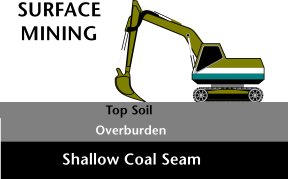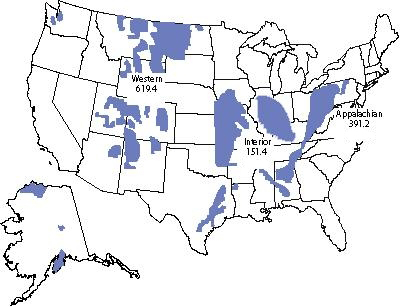|
Coal
Fuel
See
also:
other
readings with assessment in Alternative Energy -- Wind
Energy -- Geothermal Energy -- Hydropower -- Nuclear Energy
--
see
Alternative Energy Basics
|
|
|
HOW COAL WAS
FORMED
Coal is a combustible
black or brownish-black sedimentary rock composed mostly of carbon
and hydrocarbons. It is the most abundant fossil fuel produced in
the United States.
Coal is a nonrenewable
energy source because it takes millions of years to create. The
energy in coal comes from the energy stored by plants that lived
hundreds of millions of years ago, when the earth was partly covered
with swampy forests. For millions of years, a layer of dead plants
at the bottom of the swamps was covered by layers of water and dirt,
trapping the energy of the dead plants. The heat and pressure from
the top layers helped the plant remains turn into what we today
call coal.
HOW
WE GET COAL
Mining the
Coal
Coal miners
use giant machines to remove coal from the ground. They use two
methods: surface or underground mining. Many U.S. coal beds are
very near the ground's surface, and about two-thirds of coal production
comes from surface mines. Modern mining methods allow us to
easily reach most of our coal reserves. Due to growth in surface
mining and improved mining technology, the amount of coal produced
by one miner in one hour has more than tripled since 1978.
 Surface mining is used to produce most of the
coal in the U.S. because it is less expensive than underground mining.
Surface mining can be used when the coal is buried less than 200
feet underground. In surface mining, giant machines remove the top-soil
and layers of rock to expose large beds of coal. Once the mining
is finished, the dirt and rock are returned to the pit, the topsoil
is replaced, and the area is replanted. The land can then be used
for croplands, wildlife habitats, recreation, or offices or stores. Surface mining is used to produce most of the
coal in the U.S. because it is less expensive than underground mining.
Surface mining can be used when the coal is buried less than 200
feet underground. In surface mining, giant machines remove the top-soil
and layers of rock to expose large beds of coal. Once the mining
is finished, the dirt and rock are returned to the pit, the topsoil
is replaced, and the area is replanted. The land can then be used
for croplands, wildlife habitats, recreation, or offices or stores.
Underground
mining, sometimes called deep mining, is used when the
coal is buried several hundred feet below the surface. Some underground
mines are 1,000 feet deep. To remove coal in these underground mines,
miners ride elevators down deep mine shafts where they run machines
that dig out the coal. Read about a
visit to a real underground coal mine.
Processing
the Coal
After coal comes
out of the ground, it typically goes on a conveyor belt to a preparation
plant that is located at the mining site. The plant cleans and processes
coal to remove dirt, rock, ash, sulfur, and other unwanted materials,
increasing the heating value of the coal.
TRANSPORTING
COAL
After coal is
mined and processed, it is ready to be shipped to market. The cost
of shipping coal can cost more than the cost of mining it.
Most coal is
transported by train, but coal can also be transported by barge,
ship, truck, and even pipeline. About 68 percent of coal in the
U.S. is transported, for at least part of its trip to market, by
train. It is cheaper to transport coal on river barges, but barges
cannot take coal everywhere that it needs to go. If the coal will
be used near the coal mine, it can be moved by trucks and conveyors.
Coal can also be crushed, mixed with water, and sent through a "slurry"
pipeline. Sometimes, coal-fired electric power plants are built
near coal mines to lower transportation costs.
TYPES
OF COAL
Coal is classified
into four main types, or ranks (lignite, subbituminous, bituminous,
anthracite), depending on the amounts and types of carbon it contains
and on the amount of heat energy it can produce. The rank of a deposit
of coal depends on the pressure and heat acting on the plant debris
as it sank deeper and deeper over millions of years. For the most
part, the higher ranks of coal contain more heat-producing energy.
Lignite is
the lowest rank of coal with the lowest energy content. Lignite
coal deposits tend to be relatively young coal deposits that were
not subjected to extreme heat or pressure. Lignite is crumbly and
has high moisture content. There are 20 lignite mines in the United
States, producing about seven percent of U.S. coal. Most lignite
is mined in Texas and North Dakota. Lignite is mainly burned at
power plants to generate electricity.
Subbituminous
coal has a higher heating value than lignite. Subbituminous coal
typically contains 35-45 percent carbon, compared to 25-35 percent
for lignite. Most subbituminous coal in the U.S. is at least 100
million years old. About 44 percent of the coal produced in the
United States is subbituminous. Wyoming is the leading source of
subbituminous coal.
Bituminous
coal contains 45-86 percent carbon, and has two to three
times the heating value of lignite. Bituminous coal was formed under
high heat and pressure. Bituminous coal in the United States is
between 100 to 300 million years old. It is the most abundant rank
of coal found in the United States, accounting for about half of
U.S. coal production. Bituminous coal is used to generate electricity
and is an important fuel and raw material for the steel and iron
industries. West Virginia, Kentucky, and Pennsylvania are
the largest producers of bituminous coal.
Anthracite
contains 86-97 percent carbon, and has a heating value slightly
lower than bituminous coal. It is very rare in the United
States, accounting for less than one-half of a percent of
the coal mined in the U.S. All of the anthracite mines in
the United States are located in northeastern Pennsylvania.
WHERE
WE GET COAL
Coal reserves
are beds of coal still in the ground waiting to be mined. The United
States has the world's largest known coal reserves, about 263.8
billion short tons. This is enough coal to last approximately
225 years at today's level of use.
Coal production
is the amount of coal that is mined and sent to market. In 2006,
the amount of coal produced at U.S. coal mines reached an all time
high of 1,162.5 million short tons. Coal is mined in 27 states.
Wyoming mines the most coal, followed by West Virginia, Kentucky,
Pennsylvania, and Texas.Coal is mainly found in three large regions, the Appalachian
Coal Region, the Interior
Coal Region, and Western
Coal Region (includes the Powder River Basin).
Coal Production
in Three Regions,2006
Millions of Short Tons
1,162.8 million short tons

Appalachian
Coal Region:
- More than
one-third of the coal produced in the U.S. is produced in the
Appalachian Coal Region.
- West Virginia
is the largest coal-producing state in the region, and the second
largest coal-producing state in the U.S.
- Large underground
mines and small surface mines.
- Coal mined
in the Appalachian coal region is primarily used for steam generation
for electricity, metal production, and for export.
Interior
Coal Region:
- Texas is
the largest coal producer in the Interior Coal Region, accounting
for almost one-third of the regionís coal production.
- Mid-sized
surface mines.
- Mid- to large-sized
companies.
Western
Coal Region:
- Over half
of the coal produced in the U.S. is produced in the Western Coal
Region.
- Wyoming is
the largest regional coal producer, as well as the largest coal-producing
state in the nation.
- Large surface
mines.
- Some of the
largest coal mines in the world.
HOW
COAL IS USED
About 92 percent
of the coal used in the United States, is for generating electricity.
Except for a small amount of net exports, the rest of the coal is
used, as a basic energy source in many industries, including, steel,
cement and paper. The four major uses of coal are:
FOR
ELECTRIC POWER
Coal is used to generate almost half of all electricity produced
in the United States. Besides electric utility companies,
industries and businesses with their own power plants use coal to
generate electricity. Power plants burn coal to make steam. The
steam turns turbines which generate electricity.
FOR
INDUSTRY
A variety of industries use coal's heat and by-products. Separated
ingredients of coal (such as methanol and ethylene) are used in
making plastics, tar, synthetic fibers, fertilizers, and medicines.
The concrete and paper industries also burn large amounts of coal.
FOR
MAKING STEEL
Coal is baked in hot furnaces to make coke,
which is used to smelt iron ore into iron needed for making
steel. It is the very high temperatures created from the use of
coke that gives steel the strength and flexibility for products
such as bridges, buildings, and automobiles.
FOR
EXPORT
In 2006, 49.6 million short tons, or about four percent of the coal
mined, was exported to other countries from the United States.
Coal is exported to many different countries, but most trade is
with Canada, Brazil, the Netherlands, and Italy. More than
half of coal exports are used for making steel.
Coal exports
have been generally shrinking in the past 10 years, while the amount
of coal imported from other countries has been growing. In 2006,
about 36.2 million short tons of coal were imported from other
countries. Most of these imports (from Colombia, Venezuela,
and Indonesia) were shipped to electric power producers along the
U.S. coastlines. Read about a visit to a coal
export facility.
COAL
AND THE ENVIRONMENT
Environmental
laws and modern technologies have greatly reduced coal's impact
on the environment. Without proper care, mining can destroy land
and pollute water. Today, restoring the land damaged by surface
mining is an important part of the mining process. Because
mining activities often come into contact with water resources,
coal producers must also go to great efforts to prevent damage to
ground and surface waters.
When coal is
burned as fuel, it gives off carbon dioxide, the main greenhouse gas
that is linked with global warming. Burning coal also produces emissions,
such as sulfur, nitrogen oxide (NOx), and mercury, that can pollute
the air and water. Sulfur mixes with oxygen to form sulfur dioxide
(SO2), a chemical that can affect trees and water when it combines
with moisture to produce acid rain. Emissions of nitrogen oxide
help create smog, and also contribute to acid rain. Mercury that
is released into the air eventually settles in water. The mercury
in the water can build up in fish and shellfish, and can be harmful
to animals and people who eat them. The Clean Air Act and the Clean
Water Act require industries to reduce pollutants released into
the air and the water.
The coal industry
has found several ways to reduce sulfur, nitrogen oxides, and other
impurities from coal. They have found more effective ways of cleaning
coal before it leaves the mine, and coal companies look for low-sulfur
coal to mine. Power plants use "scrubbers" to clean sulfur from
the smoke before it leaves their smokestacks. In addition, industry
and government have cooperated to develop "clean coal technologies"
that either remove sulfur and nitrogen oxides from coal, or convert
coal to a gas or liquid fuel. The scrubbers and NOx removal equipment
are also able to reduce mercury emissions from some types of coal.
Scientists are working on new ways to reduce mercury emissions from
coal-burning power plants, since the Environmental Protection Agency
(EPA) has set tighter mercury limits for the future.
TEST
YOUR KNOWLEDGE OF THE MATER
|

